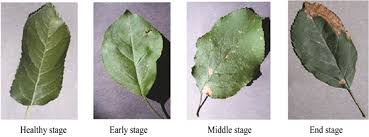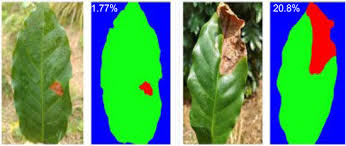Plant disease is any abnormal condition that damages a plant and reduces its productivity or usefulness to man. A diseased plant or group of diseased plants is often recognized easily once symptoms or signs become visible; however, it is the quantification of the disease that presents the challenge.
The assessment of disease incidence (i.e., the number or proportion of diseased plants in a population) is an apparently simple counting task, but is subject to the usual limitations of interpretation related to sample size.
The accurate and precise estimation or measurement of disease severity (i.e., the area or proportion of plant tissue that is symptomatic) can be a formidable task.
Disease incidence is the proportion or amount of diseased plants or parts in a population. Disease severity is the proportion of plant area that is affected.
Often, disease has to exceed a certain threshold before it reduces the yield of a crop, but it is usually difficult to accurately estimate the yield reduction caused by a specific disease.
For example, many diseases occur on senescing tissue that would not have contributed to the yield anyway. Easier diseases to assess are those that kill whole trees in orchards or plantations, and those that destroy the actual harvested product, such as fruit or grain.
Read Also: How to Extract and Package Snail Slime (Snail filtrate) for Commercial Use
Steps Involved In Assessing Disease Incidence and Severity In Crops

Assessment of the effect of disease (incidence/severity) on crop yield normally involves the following five steps:
1. Developing a descriptive growth stage key for the particular crop species – The first step to quantify the effect of disease is to develop a key that describes the growth and development of healthy plants during the growing season.
It should describe development, either from sowing to harvest in the case of annual plants, or from season to season in perennial plants.
Detailed drawings or photographs showing characteristics of the various stages of development, including leaf formation, flowering, fruiting, and senescence are needed.
Standardized growth keys have been developed for a number of crop plants, enabling comparison between different countries and different conditions.
2. Developing methods to assess the incidence and severity of disease – The disease incidence for biotrophic pathogens can be measured by counting the number of plants, leaves, flowers, etc., that are infected, but the disease severity is assessed by estimating the proportion of total photosynthetic area that is diseased.
Whether it is disease incidence, or disease severity, or both, that are measured depends on the nature of the disease.
Because judging the proportion of diseased leaf by eye is unreliable, disease assessment keys showing different disease severities as blackened areas have been devised for various crops.
3. Developing statistically sound methods of sampling crop populations for disease assessment – Once the amount of disease has been determined, the next step is to assess, either experimentally or statistically, the effect of different levels of disease on the crop yield.
The statistical approach to assessing disease involves statistical analysis of crop yields under different levels of disease that occur naturally in the field.
The levels of disease and the crop yields are monitored but not manipulated, and then yields from different seasons or areas with different levels of disease can be compared to determine the effect of disease on crop yield.
An alternative statistical approach to crop loss assessment is the use of questionnaires filled in by farmers, allowing disease and pest incidence and severity to be related to the yields they produce.
4. Estimating the negative impact of particular levels of the disease on crop yield and quality:The growth of the crop, its yield potential, the development of the disease, and its impact on yield all have to be measured to predict the impact on yield of particular levels of disease.
This information can be combined with predictions of likely disease levels to determine whether preventative treatments are worthwhile.
5. Evaluating the economic benefit from various methods available for reducing the amount of disease: Disease and crop loss assessments are necessary for evaluating the economic impact of a disease and the benefit of particular control strategies. There is no point in implementing a control measure if it will cost more than the increased crop yield will return.
Read Also: The Health Benefits of Using Accent Seasoning on your Cooking
Advantages of Disease Incidence and Severity Assessment in Agriculture

1. The method uses outcomes of real cropping situations in the field, not experimentally manipulated crops.
2. It is used to predict and forecast crop losses under different environmental situations.
3. It helps to determine whether it is economically feasible to embark on a particular control measure.
4. The development of a standardized crop key has helped to define an ideal crop situation, which in effect ensures optimal yields under ideal conditions.
Disadvantages of Disease Incidence and Severity Assessment In Agriculture
1. In the past, most crop loss assessment has been qualitative, producing vague, inaccurate, and sometimes misleading data. One major problem with this is the complex nature of disease development.
2. Rarely can disease be attributed to just one factor. Assessment of the effect of disease (incidence/severity) on crop yield is normally complex.
3. The accurate and precise estimation or measurement of disease severity can be a formidable task due to visual and measurement errors and the need for representative and adequately sized samples.
4. Statistical tools used are subject to the usual limitations of interpretation related to sample size.
Plant disease reduces the productivity or usefulness of plants to man. Symptoms are outward expressions of the disease condition, which when visible, should be quantified and assessed.
The accurate and precise estimation or measurement of disease severity (i.e., the area or proportion of plant tissue that is symptomatic) remains a formidable task, yet it is vital for improving agricultural yield and decision-making.
Do you have any questions, suggestions, or contributions? If so, please feel free to use the comment box below to share your thoughts. We also encourage you to kindly share this information with others who might benefit from it. Since we can’t reach everyone at once, we truly appreciate your help in spreading the word. Thank you so much for your support and for sharing!

